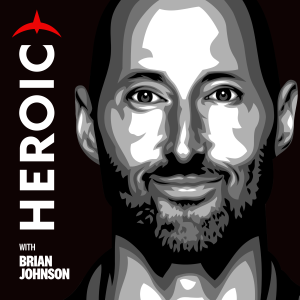
You Are Heroic with Brian Johnson
Health & Fitness:Alternative Health

In our last couple +1s, we’ve been hanging out with Emerson, playing the “I Love You!” game and taking a quick look at the story of our world.
Today we’re going to spend a little more time with Emerson and history.
First: Quick aside.
At the Optimize Coach graduation weekend, it was amazing how many of our Coaches came up to Alexandra and me and told us how much THEIR KIDS loved seeing Emerson in the +1s. (I actually got misty typing that.)
They told us that the +1s with him were a great way to share the wisdom with their kids and that their kids looked forward to more +1s with the little philosopher.
So… Here we are.
Now…
Back to The Story of the World: Volume 2: From the Fall of Rome to the Rise of the Renaissance.
After the fall of Rome, Western Europe entered what is known as the “middle ages” or the “dark ages.” Then there was a “rebirth” or renewed interest in ancient ideals that fueled the Renaissance.
As you know, a key player in the Renaissance was a guy named Galileo.
(In addition to his creation of a super-powerful telescope that let him view the moons of Jupiter that strengthened his belief in Copernicus’s theory that Earth revolved around the sun, did you know that Galileo also invented the thermometer? Might want to give ol’ G a virtual fistbump of gratitude every time you check the temperature Today!)
Which leads us to page 339 of The Story of the World Volume II and to the point of Today’s +1.
Here’s the passage: “Galileo was one of the first modern scientists, because he used the experimental method to find out how the world worked. Rather than trying to decide whether or not his ideas lined up with philosophy, Galileo made theories about the world and then tested them through doing experiments. ‘Measure what is measurable,’ he once said, ‘and if something cannot be measured, figure out how it can be.’”
Now…
I LOVE (!) the idea of running Optimizing experiments (but only all day every day) (N = 1!), but it’s that last part that got me to fold the page over.
“Measure what is measurable.” … “And if something cannot be measured, figure out how it can be.’”
When I read that, I immediately thought of virtue.
If we believe all the ancient wisdom traditions (and modern science!), virtue is THE #1 thing that’s driving our sense of flourishing and well-being.
But…
Are we measuring it?
And…
How do we measure it?
Hmmm…
Of course, there are an infinite number of ways to attempt to measure virtue, but I think the most important thing to do is to simply step back long enough from the hustle and bustle of daily living and all the “time management” we do and think about “virtue management” long enough to appreciate just how important it is.
Which is why we encourage you (and require our Coaches!) to reflect on your virtues EVERY SINGLE MORNING—identifying who you are at your best, articulating the virtues THAT version of you embodies, and then committing to BEING that Optimus-best version of yourself TODAY.
Then, for the super-serious-Optimizing scientists among us, we check in at the end of the day (channeling our inner Pythagoras) to see how we did so we can get a little better tomorrow.
That’s Today’s +1.
Virtue.
Let’s measure it.
TODAY.
More Episodes
Be Coachable: Are You? (Heroic +1 #1,706)
 2024-03-23
2024-03-23
 2024-03-23
2024-03-23
012345678910111213141516171819
Create your
podcast in
minutes
- Full-featured podcast site
- Unlimited storage and bandwidth
- Comprehensive podcast stats
- Distribute to Apple Podcasts, Spotify, and more
- Make money with your podcast
It is Free
- Privacy Policy
- Cookie Policy
- Terms of Use
- Consent Preferences
- Copyright © 2015-2024 Podbean.com



